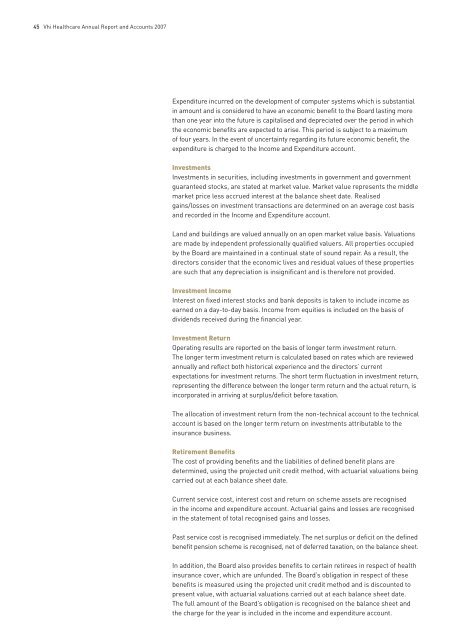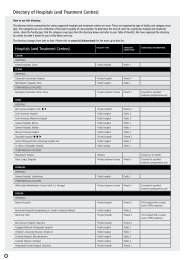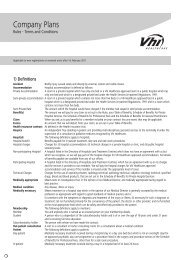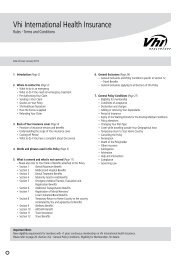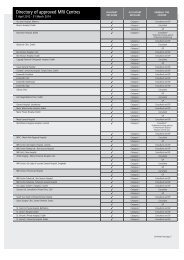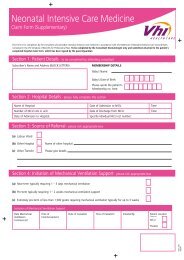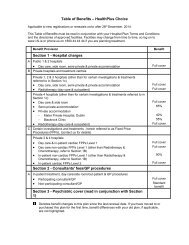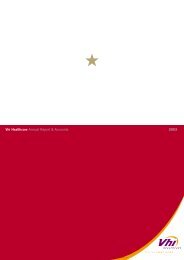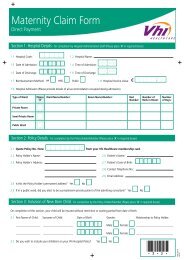2007 Annual Report - Vhi
2007 Annual Report - Vhi
2007 Annual Report - Vhi
You also want an ePaper? Increase the reach of your titles
YUMPU automatically turns print PDFs into web optimized ePapers that Google loves.
45 <strong>Vhi</strong> Healthcare <strong>Annual</strong> <strong>Report</strong> and Accounts <strong>2007</strong><br />
Expenditure incurred on the development of computer systems which is substantial<br />
in amount and is considered to have an economic benefit to the Board lasting more<br />
than one year into the future is capitalised and depreciated over the period in which<br />
the economic benefits are expected to arise. This period is subject to a maximum<br />
of four years. In the event of uncertainty regarding its future economic benefit, the<br />
expenditure is charged to the Income and Expenditure account.<br />
Investments<br />
Investments in securities, including investments in government and government<br />
guaranteed stocks, are stated at market value. Market value represents the middle<br />
market price less accrued interest at the balance sheet date. Realised<br />
gains/losses on investment transactions are determined on an average cost basis<br />
and recorded in the Income and Expenditure account.<br />
Land and buildings are valued annually on an open market value basis. Valuations<br />
are made by independent professionally qualified valuers. All properties occupied<br />
by the Board are maintained in a continual state of sound repair. As a result, the<br />
directors consider that the economic lives and residual values of these properties<br />
are such that any depreciation is insignificant and is therefore not provided.<br />
Investment Income<br />
Interest on fixed interest stocks and bank deposits is taken to include income as<br />
earned on a day-to-day basis. Income from equities is included on the basis of<br />
dividends received during the financial year.<br />
Investment Return<br />
Operating results are reported on the basis of longer term investment return.<br />
The longer term investment return is calculated based on rates which are reviewed<br />
annually and reflect both historical experience and the directors’ current<br />
expectations for investment returns. The short term fluctuation in investment return,<br />
representing the difference between the longer term return and the actual return, is<br />
incorporated in arriving at surplus/deficit before taxation.<br />
The allocation of investment return from the non-technical account to the technical<br />
account is based on the longer term return on investments attributable to the<br />
insurance business.<br />
Retirement Benefits<br />
The cost of providing benefits and the liabilities of defined benefit plans are<br />
determined, using the projected unit credit method, with actuarial valuations being<br />
carried out at each balance sheet date.<br />
Current service cost, interest cost and return on scheme assets are recognised<br />
in the income and expenditure account. Actuarial gains and losses are recognised<br />
in the statement of total recognised gains and losses.<br />
Past service cost is recognised immediately. The net surplus or deficit on the defined<br />
benefit pension scheme is recognised, net of deferred taxation, on the balance sheet.<br />
In addition, the Board also provides benefits to certain retirees in respect of health<br />
insurance cover, which are unfunded. The Board’s obligation in respect of these<br />
benefits is measured using the projected unit credit method and is discounted to<br />
present value, with actuarial valuations carried out at each balance sheet date.<br />
The full amount of the Board’s obligation is recognised on the balance sheet and<br />
the charge for the year is included in the income and expenditure account.


